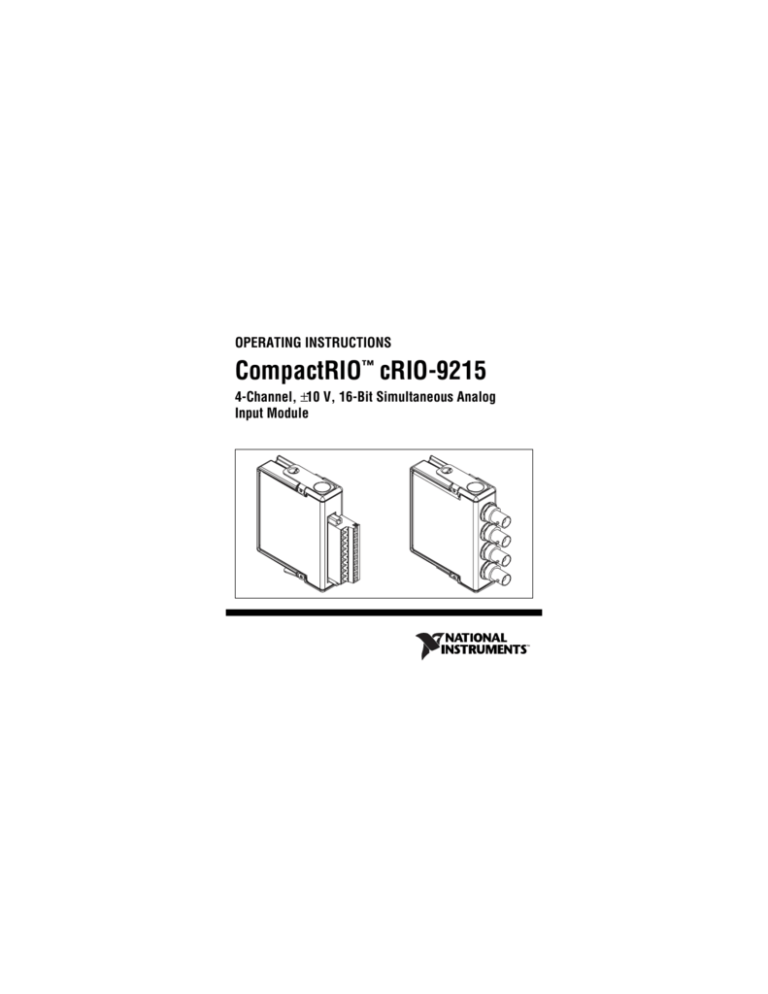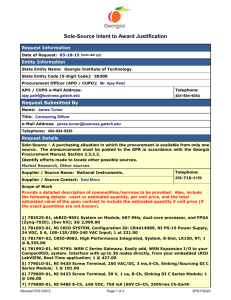
OPERATING INSTRUCTIONS
CompactRIO™ cRIO-9215
4-Channel, ±10 V, 16-Bit Simultaneous Analog
Input Module
These operating instructions describe how to use the National
Instruments cRIO-9215. In this document, the cRIO-9215 with
screw terminal and cRIO-9215 with BNC are referred to
inclusively as the cRIO-9215. For information about installing,
configuring, and programming the CompactRIO system, refer to
the CompactRIO Bookshelf at Start»All Programs»National
Instruments»CompactRIO»Search the CompactRIO
Bookshelf.
Safety Guidelines
Operate the cRIO-9215 only as described in these operating
instructions.
This icon denotes that the component may be
hot. Touching this component may result in bodily injury.
Hot Surface
Safety Guidelines for Hazardous Locations
The cRIO-9215 is suitable for use in Class I, Division 2, Groups A,
B, C, and D hazardous locations; Class 1, Zone 2, AEx nC IIC T4
and Ex nC IIC T4 hazardous locations; and nonhazardous locations
only. Follow these guidelines if you are installing the cRIO-9215
cRIO-9215 Operating Instructions
2
ni.com
in a potentially explosive environment. Not following these
guidelines may result in serious injury or death.
Caution Do not disconnect I/O-side wires or connectors
unless power has been switched off or the area is known
to be nonhazardous.
Caution Do not remove modules unless power has been
switched off or the area is known to be nonhazardous.
Substitution of components may impair
suitability for Class I, Division 2.
Caution
For Zone 2 applications, install the
CompactRIO system in an enclosure rated to at least
IP 54 as defined by IEC 60529 and EN 60529.
Caution
Special Conditions for Safe Use in Europe
This equipment has been evaluated as EEx nC IIC T4 equipment
under DEMKO Certificate No. 03 ATEX 0324020X. Each module
is marked
II 3G and is suitable for use in Zone 2 hazardous
locations.
© National Instruments Corp.
3
cRIO-9215 Operating Instructions
Safety Guidelines for Hazardous Voltages
You can connect hazardous voltages only to the cRIO-9215 with
screw terminal. Do not connect hazardous voltages to the
cRIO-9215 with BNC.
If hazardous voltages are connected to the module, take the
following precautions. A hazardous voltage is a voltage greater
than 42.4 Vpeak or 60 VDC to earth ground.
Ensure that hazardous voltage wiring is
performed only by qualified personnel adhering to local
electrical standards.
Caution
Caution Do not mix hazardous voltage circuits and
human-accessible circuits on the same module.
Make sure that devices and circuits connected to
the module are properly insulated from human contact.
Caution
When module terminals are live with hazardous
voltages, make sure that the connectors are not
accessible. You can use the cRIO-9932 connector kit or
put the CompactRIO chassis in a suitably rated enclosure.
Caution
cRIO-9215 Operating Instructions
4
ni.com
Wiring the cRIO-9215
The cRIO-9215 provides connections for four differential analog
input channels. The cRIO-9215 with screw terminal has a
10-terminal detachable screw-terminal connector. The cRIO-9215
with BNC has four BNC connectors.
Each channel of the cRIO-9215 has a terminal or center pin to
which you can connect the positive voltage signal, AI+, and a
terminal or shield to which you can connect the negative voltage
signal, AI–. The cRIO-9215 with screw terminal also has a
common terminal, COM, that is internally connected to the
isolated ground reference of the module. Refer to Table 1 for the
terminal assignments of the cRIO-9215 with screw terminal. Refer
to Figure 1 for the pin assignments of the cRIO-9215 with BNC.
© National Instruments Corp.
5
cRIO-9215 Operating Instructions
Table 1. Terminal Assignments
Module
0
1
2
3
4
5
Terminal
Signal
0
AI0+
1
AI0–
2
AI1+
3
AI1–
4
AI2+
5
AI2–
6
AI3+
7
AI3–
8
No Connection
9
Common (COM)
6
7
8
9
cRIO-9215 Operating Instructions
6
ni.com
AI0+
AI0–
AI1+
AI1–
AI2+
AI2–
AI3+
AI3–
Figure 1. BNC Connector Assignments
Connecting Differential Voltage Signals to the cRIO-9215
For grounded differential signals, connect the positive voltage
signal to AI+ and the negative signal to AI–. For the cRIO-9215
© National Instruments Corp.
7
cRIO-9215 Operating Instructions
with screw terminal, connect the signal reference to the COM
terminal.
AI+
Voltage
Source
+
–
AI–
cRIO-9215 with
Screw Terminal
COM
Figure 2. Connecting a Grounded Differential Voltage Signal to the cRIO-9215
(cRIO-9215 with Screw Terminal Shown)
For floating differential signals, the voltage source may go outside
of the common-mode signal range of the cRIO-9215 with screw
terminal. If the voltage source is outside of the common-mode
range, data read by the cRIO-9215 is not accurate. To keep the
voltage source within the common-mode range, connect the
negative lead of the signal to COM through a 1 MΩ resistor, as
shown in Figure 3. The cRIO-9215 with BNC has internal circuitry
that keeps the voltage source within the common-mode range.
cRIO-9215 Operating Instructions
8
ni.com
AI+
Voltage
Source
+
–
AI–
cRIO-9215 with
Screw Terminal
Resistor
COM
Figure 3. Connecting a Floating Differential Voltage Signal
(cRIO-9215 with Screw Terminal Shown)
Connecting Single-Ended Voltage Signals to the cRIO-9215
Connect the positive voltage signal to AI+. Connect the ground
signal to AI–. For the cRIO-9215 with screw terminal, you must
also connect the ground signal to the COM terminal to keep the
common-mode voltage in the specified range. For more
information about the common-mode voltage range, refer to the
Specifications section.
© National Instruments Corp.
9
cRIO-9215 Operating Instructions
AI+
Voltage
Source
+
–
AI–
cRIO-9215 with
Screw Terminal
COM
Figure 4. Connecting a Single-Ended Voltage Signal to the cRIO-9215
(cRIO-9215 with Screw Terminal Shown)
cRIO-9215 Circuitry
The cRIO-9215 channels share a common ground that is isolated
from other modules in the CompactRIO system. The cRIO-9215
protects each channel from overvoltages. For more information
about overvoltage protection, refer to the Specifications section.
The signal is buffered and conditioned by the instrumentation
amplifier and is then sampled by a 16-bit ADC. The channels have
independent track-and-hold amplifiers that allow you to sample all
four channels simultaneously. The cRIO-9215 returns
uncalibrated, binary data.
cRIO-9215 Operating Instructions
10
ni.com
AI+
Overvoltage
Protection
+
AI–
Overvoltage
Protection
–
COM
Isolated
ADC
Instrumentation
Amplifier
cRIO-9215 with Screw Terminal
Figure 5. Input Circuitry for One Channel on the cRIO-9215
with Screw Terminal
The cRIO-9215 with BNC has a resistor that ensures the input
voltage does not drift outside of the common-mode range.
© National Instruments Corp.
11
cRIO-9215 Operating Instructions
AI+
Overvoltage
Protection
AI–
+
Isolated
ADC
Overvoltage –
Protection
Instrumentation
100 kΩ
Amplifier
cRIO-9215 with BNC
Figure 6. Input Circuitry for One Channel on the cRIO-9215 with BNC
Sleep Mode
You can enable sleep mode for the CompactRIO system in
software. In sleep mode, the system consumes less power and may
dissipate less heat. Typically, when a system is in sleep mode, you
cannot communicate with the modules. Refer to the Specifications
section for more information about power consumption and
thermal dissipation. Refer to the CompactRIO Bookshelf for
more information about enabling sleep mode in software.
cRIO-9215 Operating Instructions
12
ni.com
NI-RIO Software
For information about determining which software you need for
the modules you are using, go to ni.com/info and enter
rdniriosoftware.
Specifications
The following specifications are typical for the range –40 to 70 °C
unless otherwise noted.
Input Characteristics
Number of channels.......................... 4 analog input channels
ADC resolution................................. 16 bits
Type of ADC..................................... Successive approximation
register (SAR)
© National Instruments Corp.
13
cRIO-9215 Operating Instructions
Operating voltage range (AI+ to AI–)
Typical .................................... ±10.4 V
Minimum1 ............................... ±10.2 V
Maximum................................ ±10.6 V
Maximum working voltage
(signal +common mode)
cRIO-9215 with
screw terminal ............................ Each channel must remain
within ±10.2 V of common
cRIO-9215 with BNC................. All inputs must remain
within ±10.2 V of the
average AI– inputs
Overvoltage protection ................... ±30 V
Conversion time
One channel................................ 4.4 µs
Two channels .............................. 6 µs
Three channels............................ 8 µs
Four channels ............................. 10 µs
1
The minimum operating voltage range is the largest voltage the cRIO-9215 can
accurately measure.
cRIO-9215 Operating Instructions
14
ni.com
Accuracy
Percent of
Reading
Percent of
Range*
Calibrated max (–40 to 70 °C)
0.2%
0.082%
Calibrated typ (25 °C, ±5 °C)
0.02%
0.014%
Uncalibrated max (–40 to 70 °C)
1.05%
0.82%
Uncalibrated typ (25 °C, ±5 °C)
0.6%
0.38%
Error
* Range equals 10.4 V
Stability
Offset drift .................................. 60 µV/ºC
Gain drift .................................... 10 ppm/ºC
CMRR (at 60 Hz).............................. –73 dB min
Input bandwidth (–3 dB)................... 420 kHz min
Input impedance
Resistance
cRIO-9215 ........................... 1 GΩ
© National Instruments Corp.
15
cRIO-9215 Operating Instructions
cRIO-9215 with BNC
(Between any two
AI– terminals) ...................... 200 kΩ
Capacitance ................................ 25 pF
Input bias current .............................. 10 nA
Input noise
RMS ........................................... 1.2 LSBrms
Peak-to-peak............................... 7 LSB
Crosstalk ........................................... –80 dB
Settling time (to 2 LSBs)
cRIO-9215 with screw terminal
10 V step .............................. 10 µs
20 V step .............................. 15 µs
cRIO-9215 with BNC
10 V step .............................. 25 µs
20 V step .............................. 35 µs
No missing codes.............................. 15 bits guaranteed
DNL .................................................. –1.9 to 2 LSB max
INL .............................................. ±6 LSB max
cRIO-9215 Operating Instructions
16
ni.com
MTBF ............................................... 1,167,174 hours at 25 °C;
Bellcore Issue 6, Method 1,
Case 3, Limited Part Stress
Method
Note Contact NI for Bellcore MTBF specifications
at other temperatures or for MIL-HDBK-217F
specifications. Go to ni.com/certification and
search by model number or product line for more
information about MTBF and other product
certifications.
Power Requirements
Power consumption from chassis (full-scale input, 100 kS/s)
Active mode ............................... 560 mW max
Sleep mode ................................. 25 µW max
Thermal dissipation (at 70 °C)
Active mode ............................... 560 mW max
Sleep mode ................................. 25 µW max
© National Instruments Corp.
17
cRIO-9215 Operating Instructions
Physical Characteristics
If you need to clean the module, wipe it with a dry towel.
Screw-terminal wiring ...................... 12 to 24 AWG copper
conductor wire with 10 mm
(0.39 in.) of insulation
stripped from the end
Torque for screw terminals ............... 0.5 to 0.6 N · m
(4.4 to 5.3 lb · in.)
Weight
cRIO-9215 with
screw terminal ............................ Approx. 150 g (5.3 oz)
cRIO-9215 with BNC................. Approx. 173 g (6.1 oz)
Safety
cRIO-9215 with Screw Terminal Safety Voltages
Connect only voltages that are within these limits.
Channel-to-COM ........................... ±30 V max
cRIO-9215 Operating Instructions
18
ni.com
Isolation
Channel-to-channel .................... No isolation between
channels
Channel-to-earth ground
Withstand ............................. 2,300 Vrms, 1 minute max
Continuous ........................... 250 Vrms,
Measurement Category II
Measurement Category II is for measurements performed on
circuits directly connected to the electrical distribution system.
This category refers to local-level electrical distribution, such as
that provided by a standard wall outlet (for example, 115 V for U.S.
or 230 V for Europe). Do not use this module with Measurement
Category III or IV voltages.
cRIO-9215 with BNC Safety Voltages
Connect only voltages that are within these limits.
AI+-to-AI–.................................... ±30 V max
© National Instruments Corp.
19
cRIO-9215 Operating Instructions
Isolation
Channel-to-channel .................... No isolation between
channels
Channel-to-earth ground
Withstand ............................. 1,500 Vrms, 1 minute max
Continuous ........................... 60 VDC,
Measurement Category I
Measurement Category I is for measurements performed on
circuits not directly connected to the electrical distribution system
referred to as MAINS voltage. MAINS is a hazardous live electrical
supply system that powers equipment. This category is for
measurements of voltages from specially protected secondary
circuits. Such voltage measurements include signal levels, special
equipment, limited-energy parts of equipment, circuits powered by
regulated low-voltage sources, and electronics. Do not use this
module with Measurement Category II, III, or IV voltages.
cRIO-9215 Operating Instructions
20
ni.com
Safety Standards
The cRIO-9215 is designed to meet the requirements of the
following standards of safety for electrical equipment for
measurement, control, and laboratory use:
•
IEC 61010-1, EN 61010-1
•
UL 61010-1
•
CAN/CSA-C22.2 No. 61010-1
Note For UL and other safety certifications, refer to the
product label, or visit ni.com/certification, search
by model number or product line, and click the
appropriate link in the Certification column.
Hazardous Locations
U.S. (UL) .......................................... Class I, Division 2,
Groups A, B, C, D, T4;
Class I, Zone 2, AEx nC
IIC T4
© National Instruments Corp.
21
cRIO-9215 Operating Instructions
Canada (C-UL) ................................. Class I, Division 2,
Groups A, B, C, D, T4;
Class I, Zone 2, Ex nC
IIC T4
Europe (DEMKO)............................. EEx nC IIC T4
Environmental
CompactRIO modules are intended for indoor use only. For
outdoor use, mount the CompactRIO system in a suitably rated
enclosure. Refer to the installation instructions for the chassis you
are using for more information about meeting these specifications.
Operating temperature
(IEC 60068-2-1, IEC 60068-2-2) ..... –40 to 70 °C
Storage temperature
(IEC 60068-2-1, IEC 60068-2-2) ..... –40 to 85 °C
Ingress protection.............................. IP 40
Operating humidity
(IEC 60068-2-56).............................. 10 to 90% RH,
noncondensing
Storage humidity
(IEC 60068-2-56).............................. 5 to 95% RH, noncondensing
cRIO-9215 Operating Instructions
22
ni.com
Maximum altitude............................. 2,000 m
Pollution Degree (IEC 60664) .......... 2
Shock and Vibration
To meet these specifications, you must panel mount the
CompactRIO system and, for the cRIO-9215 with screw terminal,
you must affix ferrules to the ends of the terminal wires.
Operating vibration,
random (IEC 60068-2-64) ................ 5 grms, 10 to 500 Hz
Operating shock
(IEC 60068-2-27).............................. 30 g, 11 ms half sine,
50 g, 3 ms half sine,
18 shocks at 6 orientations
Operating vibration,
sinusoidal (IEC 60068-2-6) .............. 5 g, 10 to 500 Hz
Electromagnetic Compatibility
Emissions.......................................... EN 55011 Class A at 10 m
FCC Part 15A above 1 GHz
© National Instruments Corp.
23
cRIO-9215 Operating Instructions
Immunity........................................... Industrial levels per EN
61326-1:1997 + A2:2001,
Table A.1
EMC/EMI ......................................... CE, C-Tick, and FCC Part 15
(Class A) Compliant
Note For EMC compliance, operate this device with
shielded cabling.
FCC Compliance
Go to ni.com/info and enter rdcriofcc for information on
using this product in compliance with FCC regulations.
CE Compliance
This product meets the essential requirements of applicable
European Directives, as amended for CE marking, as follows:
Low-Voltage Directive (safety)......... 73/23/EEC
Electromagnetic Compatibility
Directive (EMC) ............................... 89/336/EEC
Note Refer to the Declaration of Conformity (DoC) for
this product for any additional regulatory compliance
cRIO-9215 Operating Instructions
24
ni.com
information. To obtain the DoC for this product, visit
ni.com/certification, search by model number or
product line, and click the appropriate link in the
Certification column.
Calibration
You can obtain the calibration certificate for the cRIO-9215 at
ni.com/calibration.
Calibration interval ........................... 1 year
National Instruments Contact Information
National Instruments corporate headquarters is located at
11500 North Mopac Expressway, Austin, Texas, 78759-3504.
National Instruments also has offices located around the world to
help address your support needs. For telephone support in the
United States, create your service request at ni.com/support
and follow the calling instructions or dial 512 795 8248. For
telephone support outside the United States, contact your local
branch office:
Australia 1800 300 800, Austria 43 0 662 45 79 90 0,
Belgium 32 0 2 757 00 20, Brazil 55 11 3262 3599,
© National Instruments Corp.
25
cRIO-9215 Operating Instructions
Canada (Calgary) 403 274 9391, Canada (Ottawa) 613 233 5949,
Canada (Québec) 450 510 3055, Canada (Toronto) 905 785 0085,
Canada (Vancouver) 604 685 7530, China 86 21 6555 7838,
Czech Republic 420 224 235 774, Denmark 45 45 76 26 00,
Finland 385 0 9 725 725 11, France 33 0 1 48 14 24 24,
Germany 49 0 89 741 31 30, India 91 80 51190000,
Israel 972 0 3 6393737, Italy 39 02 413091,
Japan 81 3 5472 2970, Korea 82 02 3451 3400,
Malaysia 603 9131 0918, Mexico 01 800 010 0793,
Netherlands 31 0 348 433 466, New Zealand 0800 553 322,
Norway 47 0 66 90 76 60, Poland 48 22 3390150,
Portugal 351 210 311 210, Russia 7 095 783 68 51,
Singapore 65 6226 5886, Slovenia 386 3 425 4200,
South Africa 27 0 11 805 8197, Spain 34 91 640 0085,
Sweden 46 0 8 587 895 00, Switzerland 41 56 200 51 51,
Taiwan 886 2 2528 7227, Thailand 662 992 7519,
United Kingdom 44 0 1635 523545
cRIO-9215 Operating Instructions
26
ni.com
National Instruments, NI, ni.com, and LabVIEW are trademarks of National Instruments Corporation. Refer to the
Terms of Use section on ni.com/legal for more information about National Instruments trademarks. Other
product and company names mentioned herein are trademarks or trade names of their respective companies.
For patents covering National Instruments products, refer to the appropriate location: Help»Patents in your software,
the patents.txt file on your CD, or ni.com/patents.
© 2004–2005 National Instruments Corp. All rights reserved.
373779B-01
Jan05







